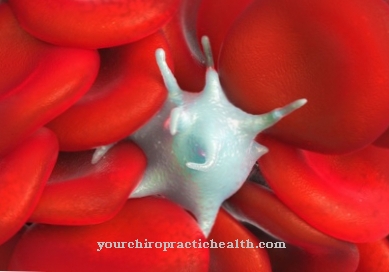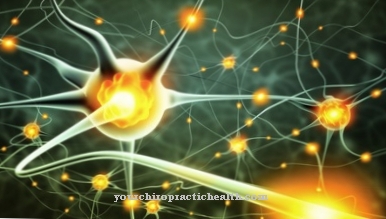Of the Frank Starling Mechanism is the autonomous regulation of the heart's internal ejection and filling capacity, which compensates for short-term fluctuations in pressure and volume. The vital regulation plays a role especially when changing the body position. The mechanism can no longer compensate for larger changes in pressure.
What is the Frank Starling Mechanism?

The heart's autonomous control circuit regulates the ejection and filling capacity of the vital organ. The regulation adapts the cardiac output to short-term pressure and volume changes and allows both chambers of the heart to eject the same stroke volume. This control loop is called the Frank Starling mechanism.
The mechanism is named after the German physiologist Otto Frank and the British physiologist Ernest Henry Starling, who first described the control loop at the beginning of the 20th century using an isolated heart and later using a heart-lung preparation. The German physiologist Hermann Straub was also involved in the first description. For this reason, the control loop is sometimes called Frank Straub Starling Mechanism designated.
The mechanism is one of several vital regulations in the human organism. The basic features of the Frank Starling Mechanism describe the volume of blood that passes through the heart during diastole and systole. The smaller the volume that flows in during diastole, the smaller the volume of blood ejected during systole.
Function & task
The Frank Starling mechanism consists of a preload and an afterload. When the auricles fill, there is talk of a preload. With an increased preload, the heart chambers also fill up increasingly. With a constant heart rate, the stroke volume of the heart increases. The end-systolic volume increases only slightly.
When the preload is increased, there is increased pressure-volume work in the heart. This principle corresponds to the preload of the Frank Starling mechanism. This preload is followed by an afterload. The outflow of blood from the heart is called the afterload. If the blood outflow occurs against increased resistance, the pumping power of the heart increases to higher pressure and in this way carries the same amount of blood as before at the same heart rate. A gradual adjustment is taking place.
Towards the end of the systole, a particularly large amount of blood remains in the heart chambers due to the increased afterload. A backwater occurs. In the diastole this back pressure causes an even greater filling. The cardiac muscle cell strength depends on the preload and is based on its preload before the actual start of the contraction. The greater the stretching of the sarcomeres in the muscle cells, the greater it is.
Because the volume in the Frank-Starling mechanism increases end-diastolic, the myosin and actin filaments overlap optimally and change from a sarcomere length of 1.9 µm to a sarcomere length of around 2.2 µm. With an optimal overlap, the maximum force is between 2.2 and 2.6 µm. If these values are exceeded, the maximum force decreases. The optimal overlap causes a so-called calcium sensitization in the myofibrils, which makes the contractile apparatus more receptive to calcium. In this way, the conventional influx of calcium at an action potential causes a stronger reaction in the myofibrils.
The blood volume of the preload is subject to certain fluctuations depending on the physical activity and the body position. The Frank-Starling mechanism ensures the heart function and the adjustment of the individual ejection volumes in the right and left parts of the heart. If the volume shifts, for example during a change in body position, the mechanism is particularly relevant.
The chamber activities are automatically adjusted by the control circuit to pressure and volume fluctuations and the associated changes in pre- and post-loads. This means that both heart chambers always pump the same stroke volume.
Illnesses & ailments
When one of the loads of the Frank Starling Mechanism is unbalanced, so does the other. The preload is referred to in medical practice as the end-diastolic volume or end-diastolic pressure, both of which can be measured. In heart diseases such as systolic heart failure, there is an increased end-diastolic volume. This also increases the filling pressure. The preload is therefore increased. As a consequence, fluid from the vascular system accumulates in the body tissue. This is how edema forms like pulmonary edema. Pulmonary edema can cause shortness of breath, rattle, or frothy sputum from the lungs, for example.
The Frank-Starling mechanism is also fraught with problems when the ventricular elasticity is reduced. A decreased elasticity of the ventricles is present, for example, in diastolic heart failure. The stiffer the ventricle, the worse the diastolic filling. This leads to a build-up of blood in the veins. To reduce the preload, the doctor gives the patient ACE inhibitors or nitrates.
Hypertension or valve stenosis can just as easily increase the heart's afterload and thus cause problems within the Frank-Starling mechanism. The ventricular muscles can hypertrophy due to increased night-time load and thus lower the wall tension.Such ventricular hypertrophy can result in heart failure. The stretching of the ventricular muscle fibers gives them greater tension, and the increased stretch allows the blood to be ejected with greater force.
If the Frank Starling mechanism fails, the heart can no longer easily carry out everyday pressure fluctuations and fluctuations in volume. The mechanism can compensate for a slightly increased pressure and a slightly increased preload in healthy people. However, the regulation mechanism is not equipped to withstand larger pressure fluctuations or load fluctuations. For this reason, larger fluctuations can have life-threatening consequences.

























.jpg)


